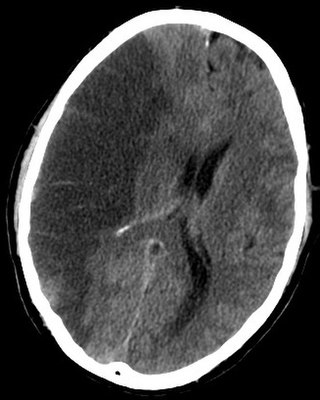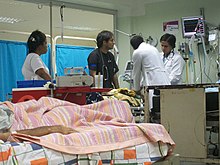Clinical death is the medical term for cessation of blood circulation and breathing, the two criteria necessary to sustain the lives of human beings and of many other organisms. It occurs when the heart stops beating in a regular rhythm, a condition called cardiac arrest. The term is also sometimes used in resuscitation research.

Hypothermia is defined as a body core temperature below 35.0 °C (95.0 °F) in humans. Symptoms depend on the temperature. In mild hypothermia, there is shivering and mental confusion. In moderate hypothermia, shivering stops and confusion increases. In severe hypothermia, there may be hallucinations and paradoxical undressing, in which a person removes their clothing, as well as an increased risk of the heart stopping.

Drowning is a type of suffocation induced by the submersion of the mouth and nose in a liquid. Most instances of fatal drowning occur alone or in situations where others present are either unaware of the victim's situation or unable to offer assistance. After successful resuscitation, drowning victims may experience breathing problems, vomiting, confusion, or unconsciousness. Occasionally, victims may not begin experiencing these symptoms until several hours after they are rescued. An incident of drowning can also cause further complications for victims due to low body temperature, aspiration of vomit, or acute respiratory distress syndrome.

Reperfusion injury, sometimes called ischemia-reperfusion injury (IRI) or reoxygenation injury, is the tissue damage caused when blood supply returns to tissue after a period of ischemia or lack of oxygen. The absence of oxygen and nutrients from blood during the ischemic period creates a condition in which the restoration of circulation results in inflammation and oxidative damage through the induction of oxidative stress rather than restoration of normal function.

Hypovolemic shock is a form of shock caused by severe hypovolemia. It could be the result of severe dehydration through a variety of mechanisms or blood loss. Hypovolemic shock is a medical emergency; if left untreated, the insufficient blood flow can cause damage to organs, leading to multiple organ failure.

Cerebral hypoxia is a form of hypoxia, specifically involving the brain; when the brain is completely deprived of oxygen, it is called cerebral anoxia. There are four categories of cerebral hypoxia; they are, in order of increasing severity: diffuse cerebral hypoxia (DCH), focal cerebral ischemia, cerebral infarction, and global cerebral ischemia. Prolonged hypoxia induces neuronal cell death via apoptosis, resulting in a hypoxic brain injury.

Brain ischemia is a condition in which there is insufficient bloodflow to the brain to meet metabolic demand. This leads to poor oxygen supply or cerebral hypoxia and thus leads to the death of brain tissue or cerebral infarction/ischemic stroke. It is a sub-type of stroke along with subarachnoid hemorrhage and intracerebral hemorrhage.
Deep hypothermic circulatory arrest (DHCA) is a surgical technique in which the temperature of the body falls significantly and blood circulation is stopped for up to one hour. It is used when blood circulation to the brain must be stopped because of delicate surgery within the brain, or because of surgery on large blood vessels that lead to or from the brain. DHCA is used to provide a better visual field during surgery due to the cessation of blood flow. DHCA is a form of carefully managed clinical death in which heartbeat and all brain activity cease.
Erika Nordby, also known as Baby Erika, Miracle Baby and Canada's Miracle Child, is a Canadian originally from Edmonton, Alberta known for having been revived after spending two hours without a heartbeat due to hypothermia. Nordby, then a 13-month-old toddler, had left her heated house nearly naked, while the air temperature was −24 °C (−11 °F).

The effects of high altitude on humans are mostly the consequences of reduced partial pressure of oxygen in the atmosphere. The medical problems that are direct consequence of high altitude are caused by the low inspired partial pressure of oxygen, which is caused by the reduced atmospheric pressure, and the constant gas fraction of oxygen in atmospheric air over the range in which humans can survive. The other major effect of altitude is due to lower ambient temperature.
Targeted temperature management (TTM) previously known as therapeutic hypothermia or protective hypothermia is an active treatment that tries to achieve and maintain a specific body temperature in a person for a specific duration of time in an effort to improve health outcomes during recovery after a period of stopped blood flow to the brain. This is done in an attempt to reduce the risk of tissue injury following lack of blood flow. Periods of poor blood flow may be due to cardiac arrest or the blockage of an artery by a clot as in the case of a stroke.
The Arctic Sun Temperature Management System is a non-invasive targeted temperature management system. It modulates patient temperature by circulating chilled water in pads directly adhered to the patient's skin. Using varying water temperatures and a computer algorithm, a patient's body temperature can be better controlled. It is produced by Medivance, Inc. of Louisville, Colorado.
Mild total body hypothermia, induced by cooling a baby to 33-34°C for three days after birth, is nowadays a standardized treatment after moderate to severe hypoxic ischemic encephalopathy in full-term and near to fullterm neonates. It has recently been proven to be the only medical intervention which reduces brain damage, and improves an infant's chance of survival and reduced disability.
Anna Elisabeth Johansson Bågenholm is a Swedish radiologist from Vänersborg, who survived after a skiing accident in 1999 left her trapped under a layer of ice for 80 minutes in freezing water. During this time she experienced extreme hypothermia and her body temperature decreased to 13.7 °C (56.7 °F), one of the lowest survived body temperatures ever recorded in a human with accidental hypothermia. Bågenholm was able to find an air pocket under the ice, but experienced circulatory arrest after 40 minutes in the water.
A hypothermia cap is a therapeutic device used to cool the human scalp. Its most prominent medical applications are in preventing or reducing alopecia in chemotherapy, and for preventing cerebral palsy in babies born with neonatal encephalopathy caused by hypoxic-ischemic encephalopathy (HIE). It can also be used to provide neuroprotection after cardiac arrest, to inhibit stroke paralysis, and as cryotherapy for migraine headaches.
Hydrogen sulfide is produced in small amounts by some cells of the mammalian body and has a number of biological signaling functions. Only two other such gases are currently known: nitric oxide (NO) and carbon monoxide (CO).
Emergency Preservation and Resuscitation (EPR) is an experimental medical procedure where an emergency department patient is cooled into suspended animation for an hour to prevent incipient death from ischemia, such as the blood loss following a shooting or stabbing. EPR uses hypothermia, drugs, and fluids to "buy time" for resuscitative surgery. If successful, EPR may someday be deployed in the field so that paramedics can suspend and preserve patients for transport.
Lance B. Becker is an American physician and academic, specializing in emergency medicine and treatment for cardiac arrest, currently at Northwell Health. He is the chairman of the department of emergency medicine at North Shore University Hospital, as well as chair and professor of emergency medicine at Hofstra Northwell School of Medicine.

Skin temperature is the temperature of the outermost surface of the body. Normal human skin temperature on the trunk of the body varies between 33.5 and 36.9 °C, though the skin's temperature is lower over protruding parts, like the nose, and higher over muscles and active organs. Recording skin temperature presents extensive difficulties. Although it is not a clear indicator of internal body temperature, skin temperature is significant in assessing the healthy function of skin. Some experts believe the physiological significance of skin temperature has been overlooked, because clinical analysis has favoured measuring temperatures of the mouth, armpit, and/or rectum. Temperatures of these parts typically are consistent with internal body temperature.
Post-cardiac arrest syndrome (PCAS) is an inflammatory state of pathophysiology that can occur after a patient is resuscitated from a cardiac arrest. While in a state of cardiac arrest, the body experiences a unique state of global ischemia. This ischemia results in the accumulation of metabolic waste which instigate the production of inflammatory mediators. If return of spontaneous circulation (ROSC) is achieved after CPR, then circulation resumes, resulting in global reperfusion and the subsequent distribution of the ischemia products throughout the body. While PCAS has a unique cause and consequences, it can ultimately be thought of as type of global ischemia-reperfusion injury. The damage, and therefore prognosis, of PCAS generally depends on the length of the patient's ischemic period; therefore the severity of PCAS is not uniform across different patients.









